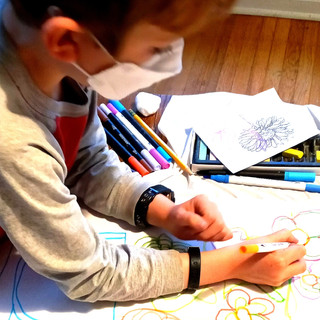Clementine Hunter
- Serene
- Jan 26, 2022
- 2 min read
Updated: Jun 22, 2022
CLEMENTINE HUNTER
1887-1988

Clementine Hunter was a self-taught Folk Artist, and the inspiration for our art projects this week. She was an amazing example of the power of art and positivity to overcome challenges and to leave an amazing legacy for generations.
She was born into a Louisiana Creole family at Hidden Hill plantation, one of seven children; her grandparents had been slaves, and her parents worked on the plantation where she was born. She never learned to read or write and worked all of her life picking cotton and as a cook and housekeeper. At 15 she moved to Melrose Plantation where she met her husband, had children, and lived the rest of her life.
Her life changed when the plantation was turned into an art colony and visitors would come for retreats to write and paint. One day while cleaning, she found some materials and used them to mark out a picture of a river baptism on a window shade. This began her career as an artist. In 1939 when she was in her 50’s, she began recording her memories and the history of the plantation. She often painted on gourds, cereal boxes, and cardboard. One of her most well-known works covers the walls of a food storage building on the grounds of Melrose, which depicts scenes of plantation life on the Cane River. It is painted with oils on plywood, in nine panels. With the support of some patrons of the plantation, she was able to practice her art and make a name for herself. One of her favorite subjects to paint was her beloved Zinnias.
Although today Clementine Hunter is considered a Folk-Art legend, she lived in near poverty for most of her life, and never traveled more than 100 miles from her home. She sometimes made money by charging people 25c for a tour of her home and the paintings she displayed there, or $1 for a photo with her and many times, gave her paintings away. In the 1940s she was selling paintings for as little as a quarter, but by the time of her death, her work was being sold to dealers for thousands of dollars. She lived to be 101 years of age, and created around 5,000 to 10,000 pieces of art, despite having first picked up a paintbrush so late in life. She is remembered as an important social and cultural historian and as a pivotal figure in Folk Art. She became the first African American artist to have a solo exhibition at the New Orleans Museum of Art and received an invitation to the White House from President Jimmy Carter. Her art has been displayed in the Dallas Museum of Fine Art, the American Folk-Art Museum, the Minneapolis Institute of Arts, and many others. In 1986, she was granted an honorary Doctor of Fine Arts degree by Northwestern State University of Louisiana. There are numerous books that have been written about her life, and Clementine Hunter's World is 2017 a documentary celebrating her life and art, directed by noted Hunter scholar, Art Shiver. In addition to the film, the Smithsonian National Museum of African American History & Culture created an exhibition centering on Hunter called "Clementine Hunter: Life on Melrose Plantation.
Here is a more detailed article on her life: https://en.wikipedia.org/wiki/Clementine_Hunter


WEDNESDAY'S CLASS

































Comments